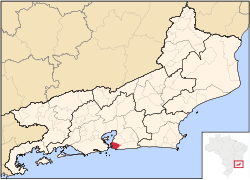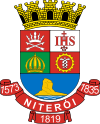Niterói
| Niterói | |||
| — Municipality — | |||
| The Municipality of Niterói | |||
 |
|||
|
|||
| Nickname(s): Cidade Sorriso (Smile City) | |||
 |
|||
| Coordinates: | |||
| Country | Brazil | ||
|---|---|---|---|
| Region | Southeast | ||
| State | Rio de Janeiro | ||
| Founded | 22 November 1573 | ||
| Incorporated | 1835 | ||
| Government | |||
| - Mayor | Godofredo Pinto (PT) | ||
| Area | |||
| - Municipality | 129.38 km² (50 sq mi) | ||
| Elevation | 0 m (0 ft) | ||
| Population (2006)[1][2] | |||
| - Municipality | 476,669 | ||
| - Density | 3,684.4/km² (9,542.6/sq mi) | ||
| - Metro | 11,620,000 | ||
| Time zone | UTC-3 (UTC-3) | ||
| - Summer (DST) | UTC-2 (UTC-2) | ||
| HDI (2000) | 0.886 – high | ||
| Website: Niterói, Rio de Janeiro | |||
Niterói is a city, and a município (county), in the state of Rio de Janeiro, southeast region of Brazil. This city was founded on November 22, 1573 by the Tupi Amerindian chief Araribóia (who later was converted to Roman Catholicism and given the Christian name of Martim Afonso, after the Portuguese explorer Martim Afonso de Souza). It makes Niteroi the only Brazilian city to have been founded by a non-Christian, non-assimilated Brazilian Amerindian.[3]
The Brazilian Niterói class of naval frigates is named after the city.
Contents |
History
Following the expelling of the French settlers from Rio de Janeiro in 1567 by Estácio de Sá (the so-called France Antarctique episode), the Portuguese crown began noticing that the bay of Rio de Janeiro would make a strategic scale for the Atlantic route of ships from Portugal to its colonies in Africa and Asia, as well an important advanced bridgehead for the defense of South Brazil. Fortresses were built and an alliance was formed with nearby native Tupi-Guarani tribes to defend the settlement against other European invaders.
Araribóia, the chief of one of these allied tribes -the Temininós- requested from the Portuguese General-Governor of Brazil, Mem de Sá, a tract of land; his request was granted, and he was rewarded with the region called "Banda D'Além" (the land beyond), in the eastern side of the bay, from River Marui to the Red Barriers between Gragoata and Boa Viagem beachs[4]. This area corresponded to what is nowadays the northwestern part of the county of Niterói, which includes the central and northern zones of its urban area. There, in the "Land Beyond", Araribóia founded the Village of Saint Lawrence of the Indians (in Portuguese, Vila de São Lourenço dos Índios), the embryo for the future city of Niterói, a Tupi name that means "Hidden Waters".
The village was visited by the king of Portugal, John VI, in 1816, who also decreed its emancipation from Rio de Janeiro in May 10 1819 and gave the new-created county a new name, Vila Real da Praia Grande (Royal Village of Long Beach).
In 1834, the city of Rio de Janeiro, capital of the new-stablished Empire of Brazil, was detached from the rest of the province of Rio de Janeiro; Vila Real da Praia Grande was then chose for the new capital of that province, while the city of Rio de Janeiro itself was converted into a neutral county, following the Ato Adicional. Niteroi served the function of capital till the year of 1975 -except for the period between 1894 and 1903 when it was temporarily transferred to the city of Petrópolis).
Vila Real da Praia Grande was officially renamed to Niterói on March 6, 1835 after the Tupi Nictheroy (hidden waters). This old spelling persisted until the mid-20th century, when the current spelling -Niterói- was adopted.
In 1890, the Brazilian provinces began being called states and the neutral county (Rio de Janeiro city) had its status changed to Federal District (or simply DF, the Brazilian acronym for Distrito Federal). Following the transference of the Brazil's capital to Brasilia DF in 1960, the city of Rio de Janeiro was made into a small, one-county state, named state of Guanabara. This state was finally absorbed by the state of Rio de Janeiro in 1975; since then, Niteroi lost its condition of the state's capital in favour of the city of Rio de Janeiro.
Growth

By the time of its emancipation, the urban area of Niteroi corresponded to its central zone and São Domingos only. The south zone -Icarai, Santa Rosa, Vital Brazil- began being urbanized in 1841, when the Santa Rosa farm was divided into estates, while Jurujuba evolved from an old fishermen colony. São Francisco and Charitas, sites named after the Catholic church built in honor to Saint Francis by the Jurujuba cove, remained scarcely populated till about 1940. As for the northern zone of Niteroi, its urbanization began in the late 19th century, when a tramway was inaugurated, allowing the expansion of the city to north and northeast, as well boosting the urban growth of the neighbour county of São Gonçalo do Amarante.
The realm of Itaipu -a former vast zone of farming lands and forests west to Niteroi- was annexed to the county in 1943. It has lost its countryside traits and its urban population has grown fast since the late 1960s.
In the early 20th century, Niteroi started its industrialization boom.
Economy

Niteroi is a modern city, with modern buildings and four main shopping malls. Its economy is centered on its trading and commerce services, like imobiliary corporations, graphic design, web design and publicity. It also hosts industries of food (especially seafood), clothes, caldle, marine objects; its negative point is that its transports depend on a small port and scarce options of roads, if compared to Rio de Janeiro's.
The city is 25 minutes from the center of Rio de Janeiro's city, the state's capital, and most populated, although Niteroi boasts the title of the second richest of the state.[5]
The Niterói Contemporary Art Museum, the city's main landmark, was designed by the famous Brazilian modernist architect Oscar Niemeyer. The landscape of the central urban area of the city is dominated by a high cilindric building though, the Niterói Tower, that hosts different professional offices and belongs to the Niterói Shopping Mall.
Niteroi has other three big shopping malls besides the Niterói Shopping Mall: the Plaza Shopping, the Itaipu Multi Center and the Baymarket. This last one occupies the former area of the Sandiz department store, demolished in the mid 1990's.
Demographics
Niteroi is 14km (8 miles) distant from Rio de Janeiro city, to which it is linked by the Rio-Niterói Bridge and two ferry-boat services. The quality of life in Niteroi is considered one of the best (3rd place) among 5,600 Brazilian cities, according to UN indexes.
Education

Niteroi is the seat of the Fluminense Federal University, one of the most important research centers in Brazil.[6] It does have others colleges such as La Salle, Maria Thereza and Candido Mendes.
Catholic schools, mainly La Salle Institute and São Vicente de Paula, are the most traditional elementary and high schools of the city. Other important schools are Assunção, Gay Lussac, the Salesian High School, pH (the school is also present in Rio de Janeiro, having scored 3rd at the municipal ENEM ranking with its unit at Tijuca), MV1 and Oswaldo Cruz Institute.
Niteroi has the highest level of literacy in the State of Rio de Janeiro.[7]
Politics

Currently, mayor of Niterói is Godofredo Pinto ( From Workers Party or Partido dos Trabalhadores in Portuguese ). Recently polls for voting intention revealed that Jorge Roberto Silveira, an old mayor of Niterói ( who was involved in the MAC Scandal ) has 56% of vote intention, distant from the second candidate, Rodrigo Neves, with 12%, candidate of the current government, that made the city lose many titles, like the Brazil's cleanest cities with the better cleaning public corporation, CLIN ( intentionally named to remember the word "clean" ) ( the Companhia de Limpeza Pública de Niterói or Niterói Public Cleaning Company ) and the title of the 4th Brazilian city with the better quality of life, the third candidate Gegê Galindo, with 8% of the vote intentions, has many historical references ( one of his grandfathers was mayor of Angra dos Reis, a city in state of Rio de Janeiro, and another of his grandfathers was the 1st judge of the Niterói's Work Courthouse ), the 4th candidate is Paulo Eduardo Gomes, from PSoL ( Partido Social da Libertação or Social Libertation Party ), who was a member of Niterói's city council, ( he joined the party togheter with old Brazilian senator Heloísa Helena, who was expelled from the workers party when she complained about another workers party senators and deputies, who was involved in Mensalão scandal ), and finally the 5th and last candidate is Edésio da Cruz Nunues, with 1% of the vote intentions, which family has a historically importance in Niterói and in Brazil ( Edésio was Secretary of Public Security of the state of Rio de Janeiro, member of that state and the federal council too ), his grandfather was a very rich farmer and land owner of all oceanc region of Niterói up to the early 1900's.
Administrative divisions

From 1943 to the late 1970s, the county of Niteroi comprised two districts only: the district of Niteroi (original area) and the district of Itaipu (acquired in 1943), which barely had an urban continuity or even proper road links to each other and were considered apart areas. The fractioning of Itaipu's farms into real estates as well its imobiliary boom after the building of the Rio-Niterói's bridge demanded a better integration between the two sides of the county which led to the improving of the roads and urban facilities and a reformation on the make up of Niteroi's administrative division. The county was reorganised into five districts. In the early 1990s, the administrative division of Niterói was altered once again, being the county now divided into twelve administrative, further subdivided into 48 neighborhoods.

|
|
|
Notable people from Niterói


- Alex Rodrigo Dias da Costa – footballer
- André Marques – TV show host, entertainer
- Arthur Maia musician (bass player)
- Baby Consuelo – singer
- Benjamin Constant – politician
- Bruno Beltrão – choreographer
- Daniel Lins Cortês – footballer
- Dedé Santana – comediant.
- Edmundo – footballer
- Fernanda Keller – Triathlete, iron-man winner
- Fernanda Young – writer,tv entertainer,actress
- Gérson – footballer
- Isaac Bardavid – actor and dubber
- Juliana Paes – Actress and model
- Leonardo – footballer
- Marcelo Ferreira – Athlete (sailing), Olympic medalist
- Murilo Benício – Actor
- Raica Oliveira – Top-model
- Sergio Mendes – musician, songwritter
- Torben Grael and Lars Grael – Athletes (sailing), Olympic medalists
References
- ↑ City Mayors: Largest Brazilian cities
- ↑ City Mayors: World's largest urban areas in 2006 (1)
- ↑ "The Niterói Secretary of Culture's official website". Niterói City Hall. Retrieved on 2007-02-25.
- ↑ Conheça Niteroi (Know Niteroi)
- ↑ Niterói à Vista - O Portal de Niterói
- ↑ UFF in numbers
- ↑ Fundação Municipal de Educação de Niterói
External links
|
|||||

